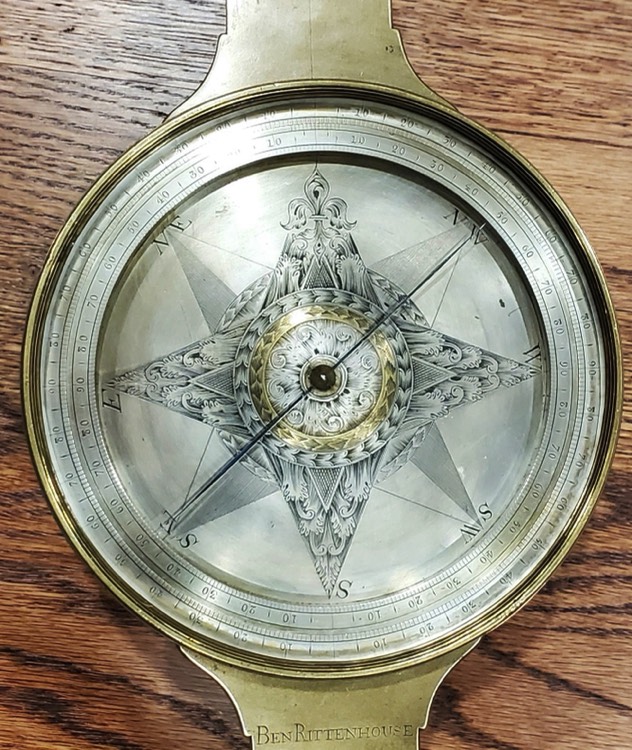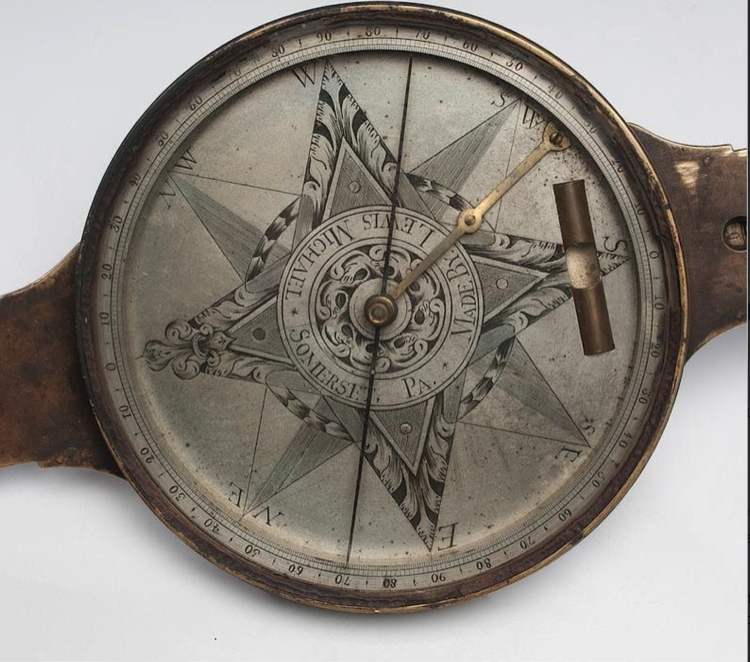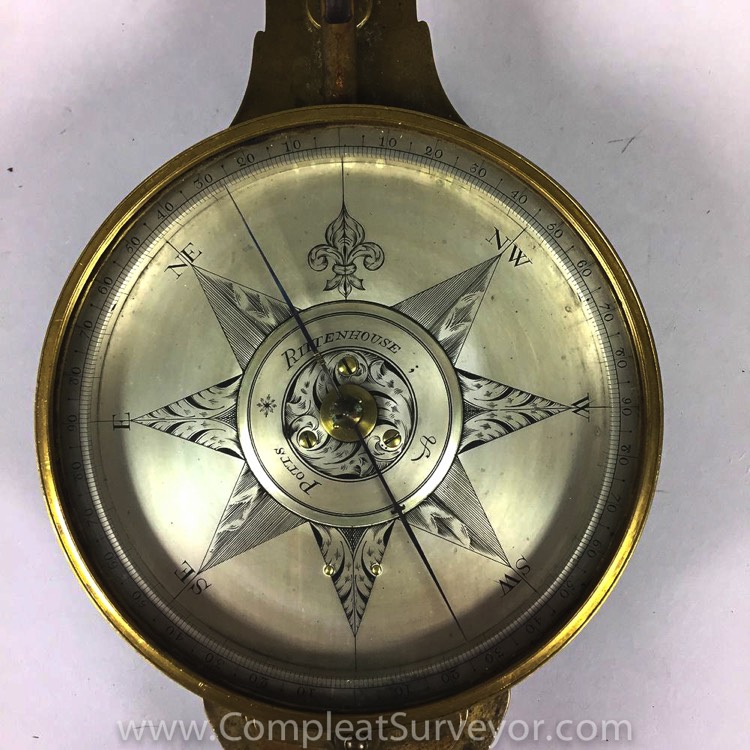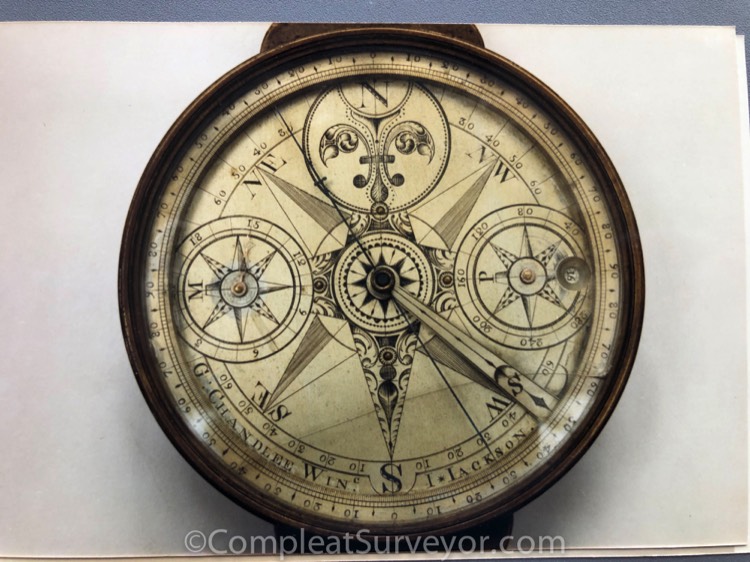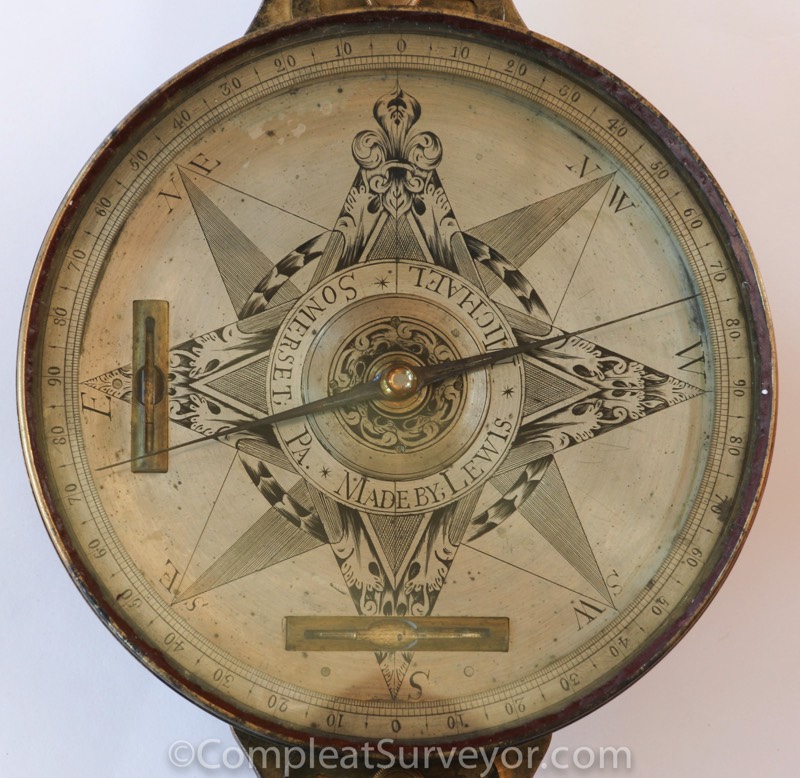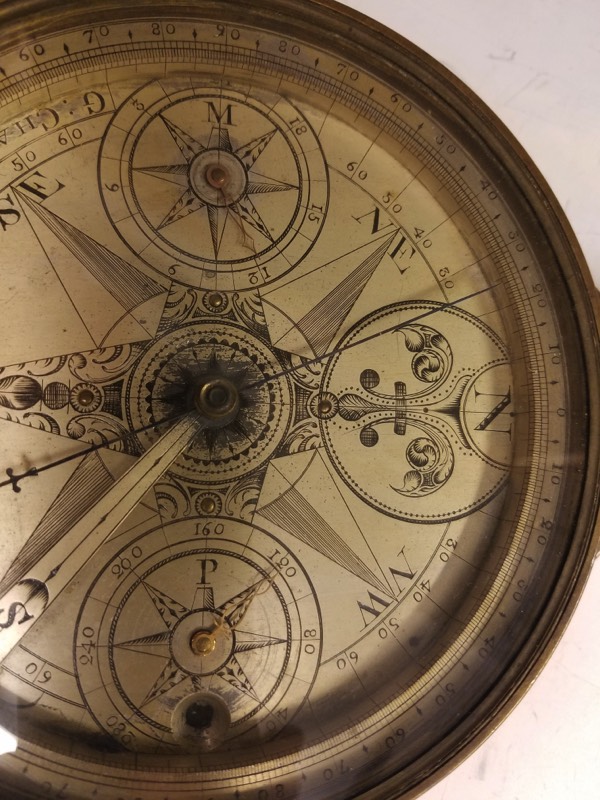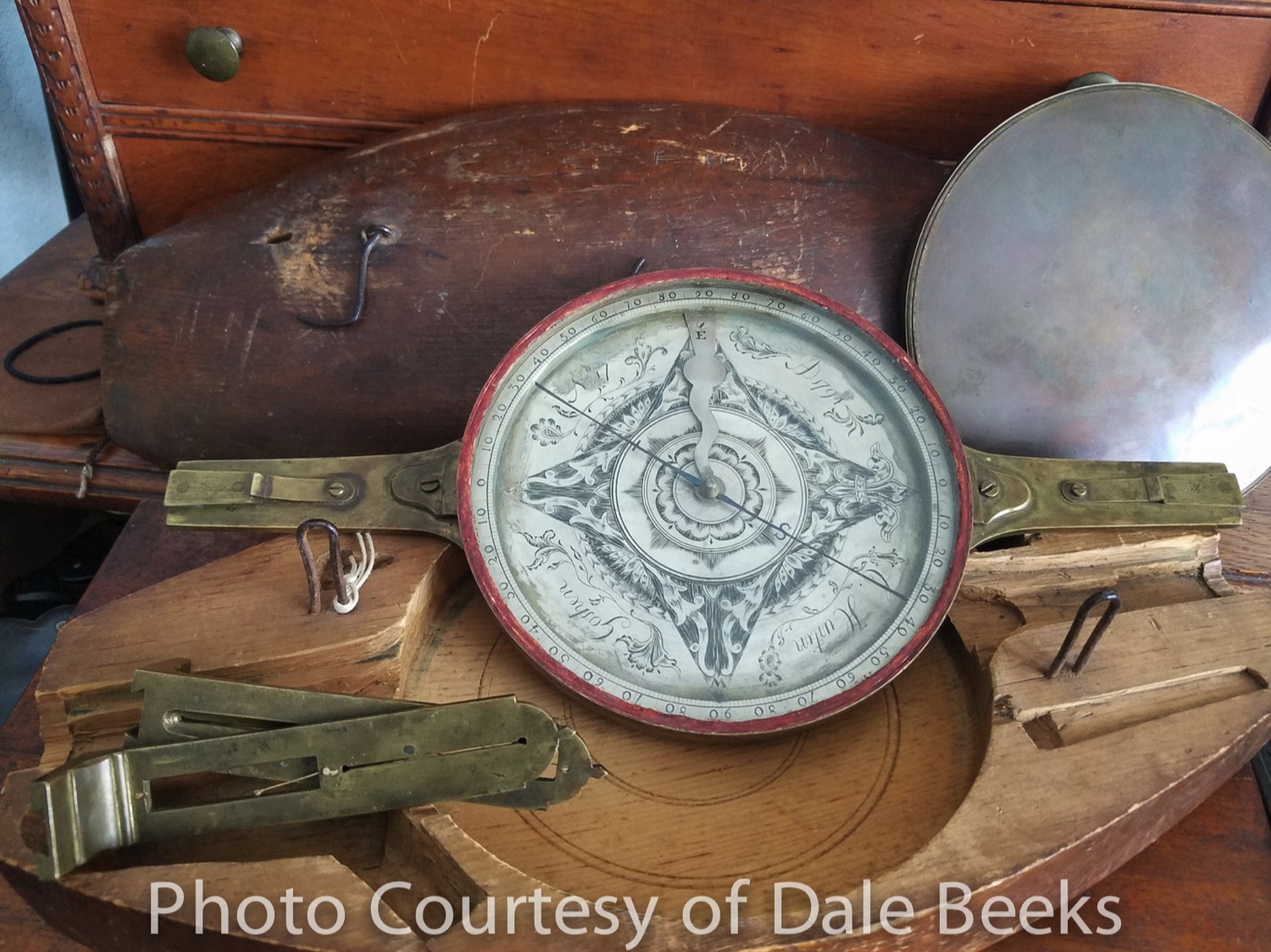
Christian Hurtin Compass - Dated 1794
The Post Revolutionary War Period
Compass making flourished after the Revolutionary War. Many instrument makers were highly skilled clockmakers, and they adapted their clockmaking tools to make surveying compasses. They produced works of breathtaking beauty, especially with brass being more available and affordable.
I see two dominant themes of engraving - the floral English style and a highly creative and artistic new American style. The floral style makers included David and Benjamin Rittenhouse, and a number of incredibly talented makers that they trained, like Lewis Michael, William Potts, and possibly John Heilig. The highly creative and artistic new American Style included Goldsmith Chandlee, Nathan Storrs, and Christian Hurtin.
Below are some beautiful examples of the Floral Style of compass engraving. Click on the picture for a full size picture.
The Rittenhouse Formal Style
The Creative Early American Style
A much more creative and distinct style of compass engraving emerged roughly 10 years after the Revolutionary War ended. This new style reflected the energy of a new nation. Compasses made by Goldsmith Chandlee, Nathan Storrs, Christian Hurtin, and a handful of others are simply works of art. Take a look at some of the beautiful examples below.

Christian Hurtin

The Refinement of Compasses
The post-Revolutionary War period also saw makers develop three helpful refinements to compasses: spirit levels, outkeepers, and inclinometers
1. Spirit Levels
Early Surveyors leveled a compass by watching the needle. The compass was level if both ends of the needle were balanced and the needle could float freely from side to side.
But adding spirit levels to a needle allowed surveyors to balance a compass more quickly. After the benefits of adding one or two levels became accepted, makers started adding levels in different ways. Some makers added a single level. Benjamin Rittenhouse added a single level that could swivel, eliminating the need for a second level. Most of the levels were external, while the Chandlees and Lewis Michael sometimes added levels inside the compass box.
Some surveyors even retrofit levels into compasses that did not originally have them.
The pics below:
A Circa 1790 Heilig Compass with two levels
A Circa 1830 Lewis Michael Compass with two levels inside the compass box
2. Outkeepers Added
Surveyors measured distances with chains, typically 33 foot or 66 foot chains (Gunter Chains). The 33 foot chains contained 50 links, the 66 foot chains contained 100 links. A 33 foot chain is also composed of 2 poles or perches (each 16.5 feet). A 66 foot chains is made up of 4 poles or perches.
In the second half of the 18th century some makers stated adding "out keeper" dials to the compasses they made. The outkeepers allowed a surveyor to keep track of how many chains had been used surveying a line. 10 chain links equalled an "1 Out" - so the surveyor would move the outkeeper dial forward every 10 chains. Most dials went up to 16 outs. If the surveyor was using a 33 foot chain, 16 Outs equalled 33 ft x 10 chains x 16, or 5280 feet, or one mile.
The pic of a Lewis Michael compass immediately below shows an out keeper on the right side of he compass - set to number 16.
The outkeeper dial system worked ok, as long as the surveyor attention to the length of the chain used (33 ft or 66 ft). Outkeepers did not distinguish between chains of different lengths - they just counted 10 chains.
Outkeepers were typically simple dials, but one compass making family, the Chandlees, turn the dials into works of art that focused on the length of the chain. The Chandlee dials recorded poles/perches. The Chandlee system was geared to a 33 ft chain (20 perches per out). Once the surveyor hit 320 perches, the line equaled 1 mile. Some of the Chandlee compasses even had a dial for Miles.
See the Goldsmith Chandlee pic next to the Lewis Michael pic - you will see the famous Chandlee Perch and Mile Dials.
3. Inclinometers
Some makers added inclinometers to compasses pre-1800. I'm not sure when makers first added inclinometers to compasses - it might have happened in the Colonial Era. But I haven't seen a compass made in the Colonial Era yet that had an inclinometer.
Inclinometers were very simple devices, and measured the slope of the ground. This allowed a surveyor to accurately calculate the length of a line when slopes were involved. Take a look at the Dod Compass pictured below. The Dod has both a Minute Compass device and an inclinometer. The inclinometer is the Needle on the East side of the Compass. The needle swings freely. The surveyor place the compass on its side, East Side up. If perfectly level, the Needle would swing to 0 on the scale marked plus or minus 40. Using the sights, the surveyor would tilt the compass up or down and look at the target. If looking down a line that was on a 5 degree slope, the inclinometer needle would swing freely to 5 degrees.
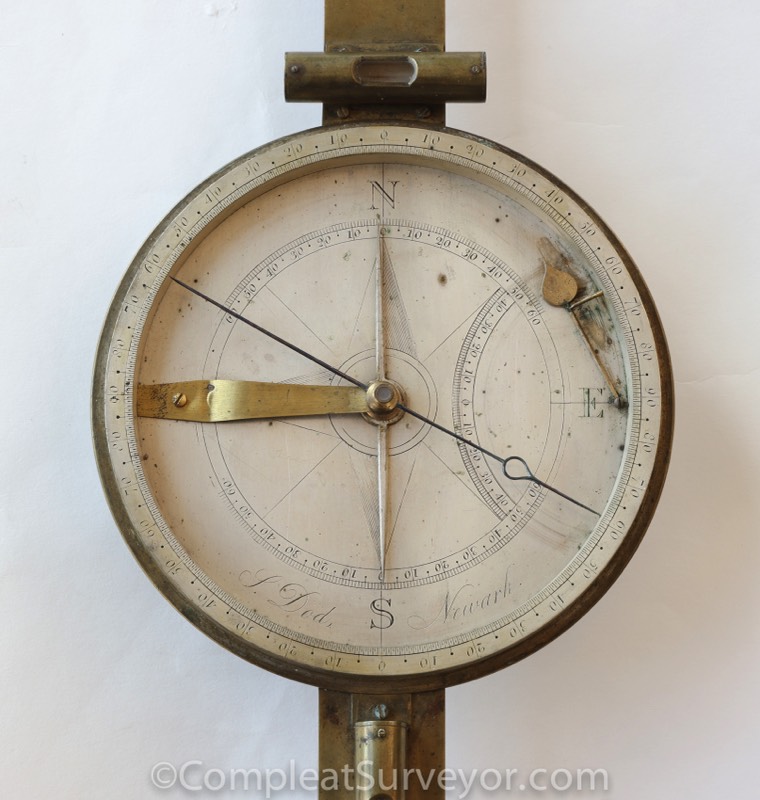
4. Verniers
As discussed in the Colonial Era Webpage, David Rittenhouse first introduced vernier compasses to America prior to the Revolutionary War. But David and especially Benjamin Rittenhouse evolved and popularized the use of verniers in post-Revolutionary Way America. Early on, vernier compasses were referred to as compasses on the Rittenhouse design. The full evolution of vernier compasses is detailed on the Vernier Compass Webpage.
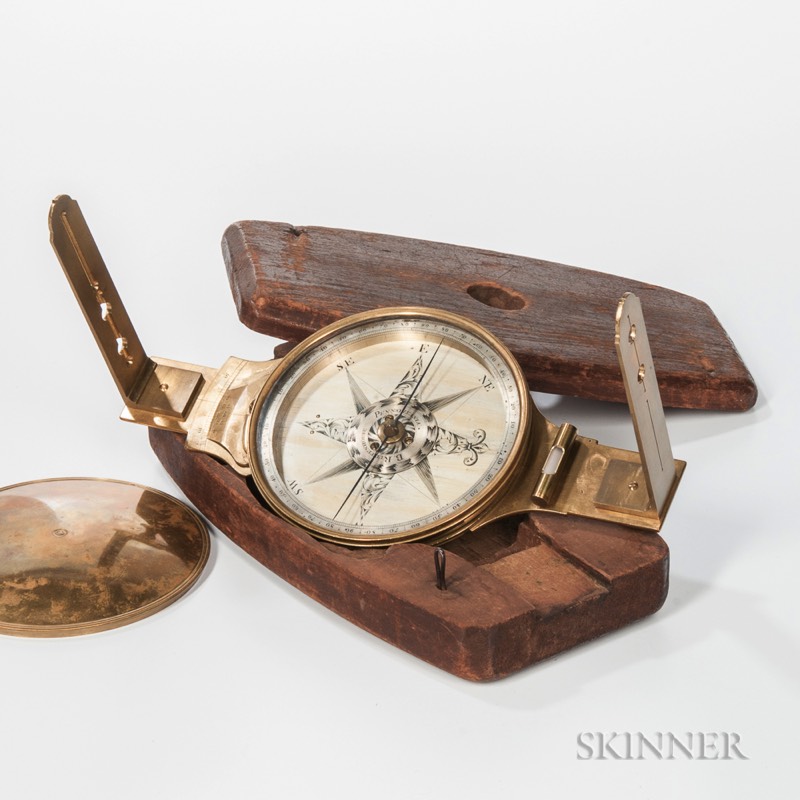
© 2020 Russ Uzes/Contact Me
